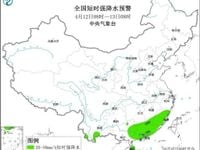On April 12, 2025, Beijing and parts of Guangdong faced severe weather conditions as the Mainland China Central Meteorological Observatory issued multiple warnings for strong convective weather, including extreme gales, blizzards, and sandstorms. This marked a significant weather event for the region, with Beijing experiencing its first city-wide orange gale warning in nearly a decade.
The winds intensified after nightfall on April 11, with gusts reaching a staggering level 14 in some areas. As a precautionary measure, gas stations across the city suspended refueling services, while several shopping malls offered free parking and temporary rest services for those seeking shelter from the storm.
In response to the extreme weather, 15 elevated sections of subway lines were suspended on Saturday, April 12, disrupting the daily commute for many residents. Additionally, flights at the Capital Airport faced potential cancellations and delays, prompting Daxing Airport to activate an emergency response.
Notably, several cultural sites, including the Summer Palace and the Temple of Heaven, were temporarily closed for public safety during the storm. The Palace Museum also announced it would be closed on April 12, 2025, further impacting local tourism.
Meanwhile, in Guangdong, significant strong convective weather was expected, characterized by thunderstorms, strong winds, and localized hail. Multiple government departments collaborated to issue warnings, advising residents to stay indoors during the storm. Ferry routes from Guangzhou's Nansha Passenger Port to Hong Kong were suspended until April 14, 2025, alongside various passenger ferry services in the Pearl River Estuary.
In Beijing, meteorological experts predicted extreme gale conditions to persist from April 11 to April 13, with wind speeds ranging from levels 11 to 13. The city also anticipated a drastic temperature drop, with forecasts indicating a decrease of 14 degrees Celsius on April 12, as well as a 24-hour temperature drop of 13 degrees Celsius. Dust and floating dust were expected to accompany the high winds, further complicating the situation.
Health experts warned that the extreme weather posed a particular risk to lighter individuals, advising those weighing less than 50 kilograms to avoid going outside. This precaution was taken seriously, as the potential for injury was high given the force of the winds.
In preparation for the incoming gales, outdoor construction work was halted early, and reinforcement measures were implemented to ensure safety. Schools also took proactive steps by letting students out early and canceling planned activities for April 12, 2025. This decision was made to protect the safety of children and staff alike.
The extreme weather event has garnered significant attention from both local and national media, highlighting the severity of the conditions and the measures being taken to protect public safety. The situation has prompted discussions about climate resilience and urban preparedness in the face of increasingly unpredictable weather patterns.
As the storm continues to unfold, officials are urging residents to stay informed through official channels and heed safety warnings. The impact of this weather event is expected to be felt across various sectors, from transportation to tourism, as the city grapples with the aftermath of the storm.
In summary, the weather conditions in Beijing and Guangdong serve as a stark reminder of the power of nature and the importance of preparedness in urban environments. As communities respond to the challenges posed by extreme weather, the need for robust infrastructure and effective communication becomes increasingly clear.





